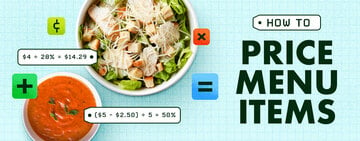

While there are several ways to measure and ensure the success of your restaurant, the best way to understand your restaurant’s financial progress is with a restaurant profit and loss statement. Also known as a restaurant P&L statement, this financial tool reflects your sales and costs during a specified period of time. To better understand your business’s growth, see our guide below to create and interpret your own restaurant profit and loss statement.
Click any of the profit and loss statement steps below to learn more about it:A profit and loss statement (or income statement) is a monetary statement that lists the sales, costs, and expenses of your business in a set period of time. For a restaurant, this financial statement enables you to analyze your restaurant's financial progress. You'll be able to see exactly where your restaurant is making or losing money, so you can take the necessary steps to improve your bottom line.
Restaurant profit and loss statements can be used weekly, monthly, or yearly. Weekly statements are recommended so you can keep track of what is most profitable or costly to your establishment each week. This allows you to quickly make changes, such as implementing strategies to lower food costs, that will ensure your restaurant's financial success. Many restaurants will also use monthly and yearly restaurant profit and loss statements to show overall progress.

A restaurant P&L statement usually includes the following 5 main sections:
P&L statement also enables you to calculate food cost percentage, gross profit, and net profit or loss. These metrics can be calculated from your sales, COGS, and costs, and they allow you to fully understand your restaurant's financial state.
Here, we go through what is included in a restaurant income statement in detail.
In this section, you should list out all of the items that contribute to your total sales. This will include the products from all of your revenue streams and how much money each specific item has brought in.
In this section, include a list of all of your restaurant's expenses with a cost of goods sold analysis. The cost of goods sold (COGS) is the total cost of your food and beverage inventory for a given time period. You can list out each individual item using your existing inventory system, calculate the cost of each product, and add them up to get your total COGS. Later, we will go through the equation for COGS and other useful restaurant calculations.

From your head chefs to your bussers, salaries and hourly wages for all employees make up your restaurant labor cost. The key element to controlling your restaurant labor cost is to understand how many employees you need to provide consistent and effective service without scheduling too many people.
Restaurant operating expenses include everything involved in your daily operations, such as supplies, repairs, and marketing. You can include occupancy expenses here or choose to make a separate section. Occupancy expenses include overhead costs and everything related to occupying a space, such as rent, insurance, utilities, taxes, and waste removal. Some of these expenditures, like waste removal, may be fixed, whereas others, such as your gas bill, may vary.
In this final section, insert the results of your calculations and see how your restaurant performed over the designated period of time. Add up your costs (COGS, Labor, Operating) and compare it to your total income. Ideally, you'll end up with a profit. If you get a negative number, you're in the red, which means you're spending more than you're bringing in. You'll need to adjust your budget at that point to ensure that your next pay period ends in a profit or else you may not be able to sustain your business in the long run.
It's a good idea to create your own restaurant profit and loss template so you can customize it to your unique costs. The table below is an example of what your P&L may look like. You can also use our free downloadable profit and loss statement template by clicking the button below.
| Restaurant Profit and Loss Statement, January 2021 | |||
|---|---|---|---|
| Sales | Week of Jan 9 | Week of Jan 16 | Week of Jan 23 |
| Food | 10,500 | 9,000 | 11,000 |
| Wine | 2,000 | 1,750 | 2,750 |
| Beer | 1,250 | 1,500 | 1,750 |
| N/A Beverages | 1,500 | 1,500 | 1,250 |
| Merchandise | 750 | 1,250 | 1,000 |
| Catering | 1,000 | 1,000 | 0 |
| TOTAL | |||
Add Labor Cost and Total Operating Cost for that week; subtract that number from Gross Profit for that week to get Net Profit/Loss.
Several restaurant calculations can help you create your profit and loss statement and glean important information from it. Below we go through how to calculate the cost of goods sold, food cost percentage, total gross profit, and net profit.
A restaurant P&L is customizable to your needs, so it is wise to avoid relying on another restaurant's profit and loss statement as an example to follow. Yours can be as rudimentary or elaborate as you like. Additionally, you can break down your operating expenses into smaller sections, such as occupancy expenses and marketing. Either way, your P&L statement will be most helpful to your business if it includes the precise costs and gains uniquely relevant to your establishment.
With precision and organization, you can be well on your way to creating an accurate profit and loss statement. Understanding your financial progress allows you to forecast sales, discern your restaurant's limitations, and ultimately grow your business.
The information provided on this website does not, and is not intended to, constitute legal advice. Please refer to our Content Policy for more details.

Restaurant Accounting Tips
While running a restaurant may begin with a talent for cooking and a passion for hospitality, you can only gain and maintain a profit in your business

Types of Restaurant Ownership Structures
Deciding how your business is going to be structured depends a lot on what type of business you want to open, how many people are already invested in

Restaurant Menu Pricing
Menu pricing is the engine behind your company's success, as sales are your restaurant's sole source of revenue. When creating or updating your menu,